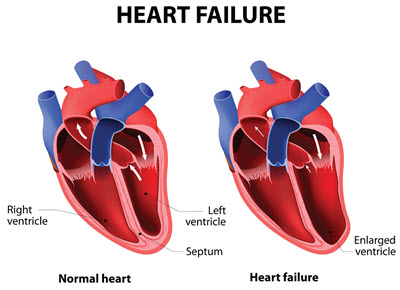Brush up on Heart Failure Reporting Skills
Hint: Learn the heart failure scales. Diagnostic coding can be tricky because ICD-10-CM offers specific code options, and you must read the documentation carefully to select the appropriate code for your claims. For example, with heart failure, not only do you have certain codes for systolic and diastolic heart failure, but you also have choices for combined systolic and diastolic heart failure. Reporting the incorrect code could result in denials. Read on to learn more. Differentiate Between Acute, Chronic Heart Failure The term “heart failure” may make it seem as though the patient’s heart stops beating, but that is not the case. Instead, with heart failure, the patient’s heart does not pump blood adequately to meet their body’s need for blood and oxygen. In turn, blood and fluids can back up in their lungs, hands, and feet. You will see ICD-10-CM codes for both acute and chronic heart failure. Acute heart failure develops suddenly, and the symptoms are initially severe. Example: If your cardiologist documents acute systolic congestive heart failure, you should report I50.21 (Acute systolic (congestive) heart failure). Chronic heart failure usually develops slowly, over time. Those who have chronic heart failure usually have a previous history of heart failure and are on long-term management such as medications to control the heart failure. Example: If your cardiologist documents chronic systolic congestive heart failure, you should report I50.22 (Chronic systolic (congestive) heart failure). Know the Acronyms for Documentation Clarity Your cardiologist might use common acronyms, HFrEF and HFpEF, in the documentation for heart failure. HFrEF: Your cardiologist may identify heart failure with reduced ejection fraction, also known as systolic heart failure, with the acronym HFrEF. With systolic heart failure, the left ventricle of the heart is not able to contract normally, so the heart can’t pump with enough force to push enough blood into circulation. Category I50.2- (Systolic (congestive) heart failure) includes heart failure with reduced ejection fraction (HFrEF) and systolic left ventricular heart failure, per ICD-10-CM. Hence the HFrEF acronym. To report systolic congestive heart failure, look to the following codes: HFpEF: Your cardiologist may identify heart failure with preserved ejection fraction, also called diastolic failure, with the acronym HFpEF. With this condition, the muscle of the left ventricle has become stiff and won’t relax normally. So, the heart doesn’t adequately fill with blood during the resting period between each heartbeat. Category I50.3- (Diastolic (congestive) heart failure) includes diastolic left ventricular heart failure, heart failure with normal ejection fraction, and heart failure with preserved ejection fraction (HFpEF). To report diastolic congestive heart failure, look to the following codes: Coding tip: “If the provider does not specify ‘failure’ in his documentation, a code from I50.X will not be assigned. For example, if the provider only documents left ventricular dysfunction, you would report code I51.9 (Heart disease, unspecified), not a code from the I50.X category,” says Robin Peterson, CPC, CPMA, manager of professional coding and compliance services, Pinnacle Enterprise Risk Consulting Services, LLC in Centennial, Colorado. Don’t Forget These Combination Codes Not only does ICD-10-CM offer specific codes for both systolic and diastolic heart failure, but you also have choices for combined systolic and diastolic heart failure. In this case, you would look to category I50.4- (Combined systolic (congestive) and diastolic (congestive) heart failure). Your code choices are as follows: Don’t miss: According to ICD-10-CM, the above codes also include combined systolic and diastolic left ventricular heart failure and heart failure with reduced ejection fraction and diastolic dysfunction. It’s important to talk with your providers about documenting whether the heart failure is diastolic, systolic, or combined and whether the heart failure is acute, chronic, or acute on chronic, Peterson says. Focus on Heart Failure Scales Your cardiologist may list a classification to indicate the severity or stage of heart failure in the documentation. These classifications come from two scales: the New York Heart Association (NYHA) scale and the American College of Cardiology (ACC)/American Heart Association (AHA). NYHA scale: The NYHA scale is symptom-based; the patient will be put into one of the following four categories based on their symptoms: ACC/AHA scale: The ACC/AHA scale is a stage-based:





